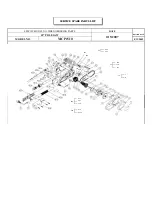
6 • ENGLISH
pull the saw backward while the blade is in
motion or KICKBACK may occur. I
nvestigate
and take corrective actions to eliminate the cause
of blade binding.
c. When restarting a saw in the workpiece, center
the saw blade in the kerf and check that the
saw teeth are not engaged into the material.
If saw blade is binding, it may walk up or KICKBACK
from the workpiece as the saw is restarted.
d. Support large panels to minimize the risk of
blade pinching and KICKBACK.
Large panels
tend to sag under their own weight. Support must
be placed under the panel on both sides, near the
line of cut and near the edge of the panel.
e. Do not use dull or damaged blade.
Unsharpened
or improperly set blades produce narrow kerf causing
excessive friction, blade binding, and KICKBACK.
f. Blade depth and bevel adjusting locking levers
must be tight and secure before making cut. I
f
blade adjustment shifts while cutting, it may cause
binding and KICKBACK.
g.
Use extra caution when making a “Pocket Cut”
into existing walls or other blind areas.
The
protruding blade may cut objects that can cause
KICKBACK.
SAFETY INSTRUCTIONS FOR CIRCULAR
SAWS WITH OUTER OR INNER PENDULUM
GUARDS AND WITH TOW GUARD
a) Check lower guard for proper closing before each
use. Do not operate the saw if lower guard does
not move freely and close instantly. Never clamp
or tie the lower guard into the open position.
If
saw is accidentally dropped, lower guard may be bent.
Raise the lower guard with the retracting handle and
make sure it moves freely and does not touch the
blade or any other part, in all angles and depths of cut.
b) Check the operation of the lower guard spring.
If the guard and the spring are not operating
properly, they must be serviced before use.
Lower
guard may operate sluggishly due to damaged parts,
gummy deposits, or a buildup of debris.
c) Lower guard should be retracted manually
only for special cuts such as “plunge cuts” and
“compound cuts.” Raise lower guard by retracting
handle and as soon as blade enters the material,
the lower guard must be released.
For all other
sawing, the lower guard should operate automatically.
d) Always observe that the lower guard is covering
the blade before placing saw down on bench or
floor.
An unprotected, coasting blade will cause the
saw to walk backwards, cutting whatever is in its path.
Be aware of the time it takes for the blade to stop after
switch is released.
ADDITIONAL SAFETY INSTRUCTIONS
f
Use clamps or another practical way to secure
and support the workpiece to a stable platform.
Holding the work by hand or against your body leaves
it unstable and may lead to loss of control.
f
Keep your body positioned to either side of
the blade, but not in line with the saw blade.
KICKBACK could cause the saw to jump
backwards (see Causes and Operator Prevention
of Kickback and KICKBACK).
f
Avoid cutting nails. Inspect for and remove all
nails from lumber before cutting.
f
Always make sure nothing interferes with the
movement of the lower blade guard.
f
Accessories must be rated for at least the speed
recommended on the tool warning label.
Wheels
and other accessories running over rated speed can
fly apart and cause injury. Accessory ratings must
always be above tool speed as shown on tool nameplate.
f
Always make sure the saw is clean before using.
f
Stop using this saw and have it properly serviced if
any unusual noise or abnormal operation occurs.
f
Always be sure all components are mounted properly
and securely before using tool.
f
Always handle the saw blade with care when
mounting or removing it or when removing the
diamond knockout.
f
Always wait until the motor has reached full speed
before starting a cut.
f
Always keep handles dry, clean and free of oil and grease.
Hold the tool firmly with both hands when in use.
f
Always be alert at all times, especially during
repetitive, monotonous operations. Always be sure of
position of your hands relative to the blade.
f
Stay clear of end pieces that may fall after cutting
off. They may be hot, sharp and/or heavy. Serious
personal injury may result.
f
Replace or repair damaged cords. Make sure your
extension cord is in good condition. Use only 3-wire
extension cords that have 3-prong grounding-type
plugs and 3-pole receptacles that accept the
tool’s plug.
f
An extension cord must have adequate wire size
(AWG or American Wire Gauge) for safety.
The
smaller the gauge number of the wire, the greater
the capacity of the cable, that is 16 gauge has more
capacity than 18 gauge. An undersized cord will cause
a drop in line voltage resulting in loss of power and
overheating. When using more than one extension
to make up the total length, be sure each individual
extension contains at least the minimum wire size.
The following table shows the correct size to use
depending on cord length and nameplate ampere
Содержание CS1004
Страница 1: ...CS1004 English 4 繁體中文 11 한국어 18 ภาษาไทย 25 Bahasa Indonesia 32 Tiếng Việt 39 www blackanddecker com ...
Страница 2: ...FIG A FIG C FIG B FIG D 1 3 12 11 2 14 10 9 6 5 4 8 13 7 15 ...
Страница 3: ...FIG H FIG J FIG I FIG K Surface of wood Tip of tooth FIG E FIG G FIG F 10 15 5 9 10 14 ...







































